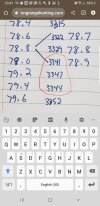-
If you are being asked to change your password, and unsure how to do it, follow these instructions. Click here
You are using an out of date browser. It may not display this or other websites correctly.
You should upgrade or use an alternative browser.
You should upgrade or use an alternative browser.
Interesting ladder test results. Ideas?
- Thread starter Nevrsummr
- Start date
 Help Support Long Range Hunting Forum
Help Support Long Range Hunting Forum
Huntnful
Well-Known Member
I believe you're referring to the magneto speed. Not the lab radar. And yes the magneto definitely effect POI and potentially accuracy as well.I wouldn't shoot groups with it on and DEFINITELY don't sight in with it on.I and a number of other shooters at the range have had issues using the Labradar. Not that it didn't measure velocity well, it measured great and repeatably. It affected the point of impact of shots down range more so with longer barrel rifles 22" and up. It changes the harmonics of the barrel. Use it to find your optimal velocity then take it off and fire for accuracy, I've seen it throw shots off as much as an inch at 100yds, much worse as range increases. Just some food for thought.
SSG Graybush
Well-Known Member
Shoot 79.1 , 79.2, 79.3 see which gives lowest ES.
Attachments
Sorry, I stand corrected. I knee jerked on the Labradar before my coffee. Yes it is magnetospeed chronographs. I tried to remove that post but could not.I believe you're referring to the magneto speed. Not the lab radar. And yes the magneto definitely effect POI and potentially accuracy as well.I wouldn't shoot groups with it on and DEFINITELY don't sight in with it on.
bassassassin104
Well-Known Member
I agree  with SSG Graybush. Looks like 79-79.4 (3340-3350fps) is where it wants to be. Don't be surprised if you have to adjust the charge weight to achieve the same velocity once the brass has all been shot and resized.
with SSG Graybush. Looks like 79-79.4 (3340-3350fps) is where it wants to be. Don't be surprised if you have to adjust the charge weight to achieve the same velocity once the brass has all been shot and resized.
Can everyone stop, go back and read his post. He's getting ejector marks at 79. FFS read before you give junk advice.
That brass is pretty crap but I'm sure it's all you can find. I do agree that your powder test is a bit fine for a large case. I would have started lower and used .5gr increments.
I'm not familiar with those bullets in that case so I'm not sure if you are in the range for velocity or not. Where did you get initial load data?
Despite what a lot of people are saying ladder tests can and do seem to work.
That brass is pretty crap but I'm sure it's all you can find. I do agree that your powder test is a bit fine for a large case. I would have started lower and used .5gr increments.
I'm not familiar with those bullets in that case so I'm not sure if you are in the range for velocity or not. Where did you get initial load data?
Despite what a lot of people are saying ladder tests can and do seem to work.
bassassassin104
Well-Known Member
Not sure who you are addressing, but I personally read every single post. I have also had the opportunity to help with load development on two 28 noslers. One shooting 195 EOL Berger's and the other a 175 eldx. Both guns ended up with H1000 and both were over 79 grains. One was over 80 grains. In my limited experience, Nosler brass show marks easily and may not be a good indicator of pressure. Also, generally speaking, that load is well below the 84 grain max charge and even below the 80 grain starting load listed by Nosler for 150 class bullets with H1000. (Yes, I know he is shooting a 155) Every gun is different, but probably not by 5 grains. The only thing I am not sure of is the solid projectile. I have very little experience with them and am not sure if they create pressure at a lower charge than a cup and core. I do agree with you, that ladder tests can be effective. It is a little difficult to get great information at 100 yards, but since he has chronograph data to go with it, he has strong potential starting point.Can everyone stop, go back and read his post. He's getting ejector marks at 79. FFS read before you give junk advice.
That brass is pretty crap but I'm sure it's all you can find. I do agree that your powder test is a bit fine for a large case. I would have started lower and used .5gr increments.
I'm not familiar with those bullets in that case so I'm not sure if you are in the range for velocity or not. Where did you get initial load data?
Despite what a lot of people are saying ladder tests can and do seem to work.
Last edited:
12fps at over 3300 is nothing.
Where did you get the load weights? Are you using auto balance/dispenser? I think the loads should be identical My Gen 6 weighs to my set target and shows me the weight actually dispensed which is usually identical for all rounds.
One thing that is a long shot is did you invert the powder can to make sure the powder is homogenous? I always do that so there is no clumping or the bottom of can has different amt of solvent than the top due to setting on the shelf. Just some ideas.
Another thought, if you do this again is do two identical loads for each step in the ladder.
Where did you get the load weights? Are you using auto balance/dispenser? I think the loads should be identical My Gen 6 weighs to my set target and shows me the weight actually dispensed which is usually identical for all rounds.
One thing that is a long shot is did you invert the powder can to make sure the powder is homogenous? I always do that so there is no clumping or the bottom of can has different amt of solvent than the top due to setting on the shelf. Just some ideas.
Another thought, if you do this again is do two identical loads for each step in the ladder.
Last edited:
+178.7-78.9 test those
As regards your comments about the bump in velocity followed by a sill or less velocity at increased charge weight, you may find this thread interesting and thought provoking.......its something I have seen and experienced too.Doing load development on a few rifles and got some interesting results. How should i interpret the bump in velocity followed by drop in velocity? As far as the ES being sporadic i am also baffled. Same reloading process in other rifles and im getting single digit ES. The last 3 shot group was the best group of the day, but seeing very faint ejector mark. All shots were taken at high temps. 90 degrees in the shade. Only fired 2 rounds and cycled rifles to allow cool down.

Why I think the Satterlee and Audette Ladder Tests Work and Why-- You Decide!
Here's a graph of velocity vs. charge weight for N565 in a 338 LM Now using the actual velocities from chronograph and putting them in the QL model to back calculate burn rate one can look at burn rate over charge weight and pressure changes over time as charge weight goes up...
Ejector ring/wipe is a sure sign of over-pressure, as long as it isn't a false positive.Can everyone stop, go back and read his post. He's getting ejector marks at 79.
Also, when brass is pushed like that toward the upper limit, the brass will give out, despite "functioning" correctly. This makes subsequent firings wildly non uniform. As the brass gives against the pressure, the velocity will drop, despite more powder. So, if you put in more powder, and velocity drops consistently, then you know for CERTAIN you are over pressure. That combined with ejector ring/wipe on brass is a certainty of being over pressure. Don't run there. Period.
Come down to the low node, and be happy and stable. Also, I do not subscribe to the velocity "flat spot" driven load development strategy. Not at all. How the shots print on target is the critical aspect. Velocity is not a factor other than a result.
-----------
Follow on Instagram
Subscribe on YouTube
Amazon Affiliate

As an Amazon Associate we earn from qualifying purchases.
Yes, the final arbiter is the group on the target. So, whether exploring a velocity sill or minimum vertical dispersion on a ladder test at range, if the target doesnt confirm something its not the sweet spot.Ejector ring/wipe is a sure sign of over-pressure, as long as it isn't a false positive.
Also, when brass is pushed like that toward the upper limit, the brass will give out, despite "functioning" correctly. This makes subsequent firings wildly non uniform. As the brass gives against the pressure, the velocity will drop, despite more powder. So, if you put in more powder, and velocity drops consistently, then you know for CERTAIN you are over pressure. That combined with ejector ring/wipe on brass is a certainty of being over pressure. Don't run there. Period.
Come down to the low node, and be happy and stable. Also, I do not subscribe to the velocity "flat spot" driven load development strategy. Not at all. How the shots print on target is the critical aspect. Velocity is not a factor other than a result.
-----------
Follow on Instagram
Subscribe on YouTube
Amazon Affiliate

As an Amazon Associate we earn from qualifying purchases.
Simply answer use 79gr.
+1 to what Zen Archery said on 1st reply, page 1
